Jakob Uszkoreit
Scene Representation Transformer: Geometry-Free Novel View Synthesis Through Set-Latent Scene Representations
Nov 29, 2021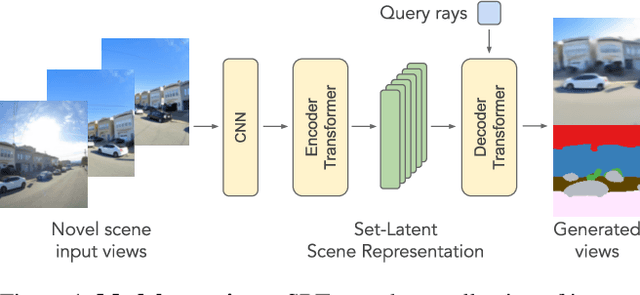
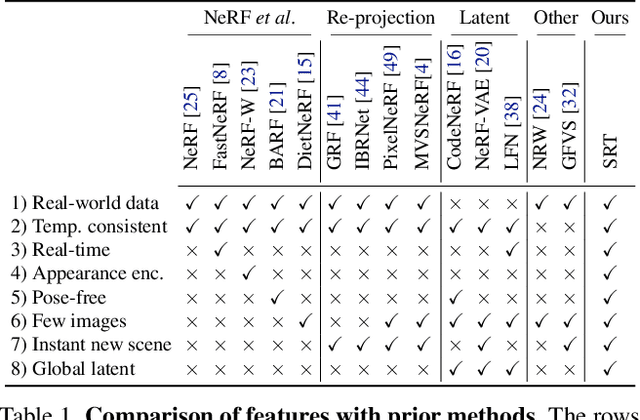
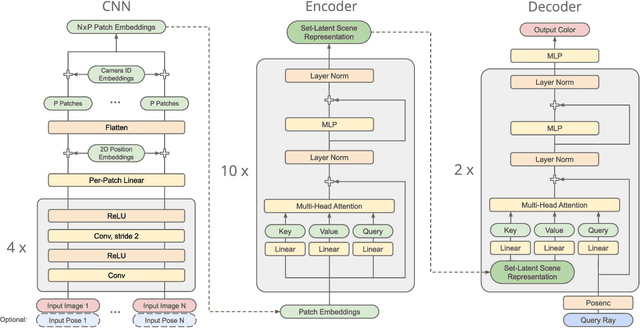

Abstract:A classical problem in computer vision is to infer a 3D scene representation from few images that can be used to render novel views at interactive rates. Previous work focuses on reconstructing pre-defined 3D representations, e.g. textured meshes, or implicit representations, e.g. radiance fields, and often requires input images with precise camera poses and long processing times for each novel scene. In this work, we propose the Scene Representation Transformer (SRT), a method which processes posed or unposed RGB images of a new area, infers a "set-latent scene representation", and synthesises novel views, all in a single feed-forward pass. To calculate the scene representation, we propose a generalization of the Vision Transformer to sets of images, enabling global information integration, and hence 3D reasoning. An efficient decoder transformer parameterizes the light field by attending into the scene representation to render novel views. Learning is supervised end-to-end by minimizing a novel-view reconstruction error. We show that this method outperforms recent baselines in terms of PSNR and speed on synthetic datasets, including a new dataset created for the paper. Further, we demonstrate that SRT scales to support interactive visualization and semantic segmentation of real-world outdoor environments using Street View imagery.
How to train your ViT? Data, Augmentation, and Regularization in Vision Transformers
Jun 18, 2021



Abstract:Vision Transformers (ViT) have been shown to attain highly competitive performance for a wide range of vision applications, such as image classification, object detection and semantic image segmentation. In comparison to convolutional neural networks, the Vision Transformer's weaker inductive bias is generally found to cause an increased reliance on model regularization or data augmentation (``AugReg'' for short) when training on smaller training datasets. We conduct a systematic empirical study in order to better understand the interplay between the amount of training data, AugReg, model size and compute budget. As one result of this study we find that the combination of increased compute and AugReg can yield models with the same performance as models trained on an order of magnitude more training data: we train ViT models of various sizes on the public ImageNet-21k dataset which either match or outperform their counterparts trained on the larger, but not publicly available JFT-300M dataset.
MLP-Mixer: An all-MLP Architecture for Vision
May 17, 2021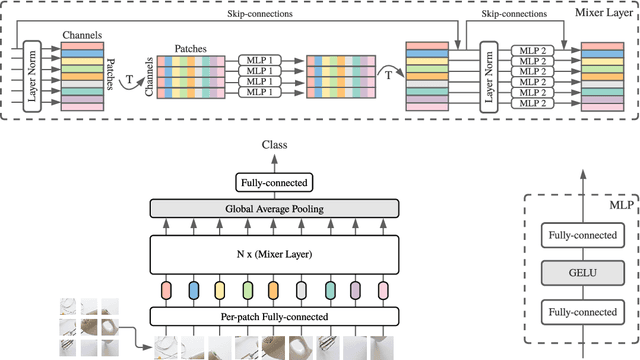

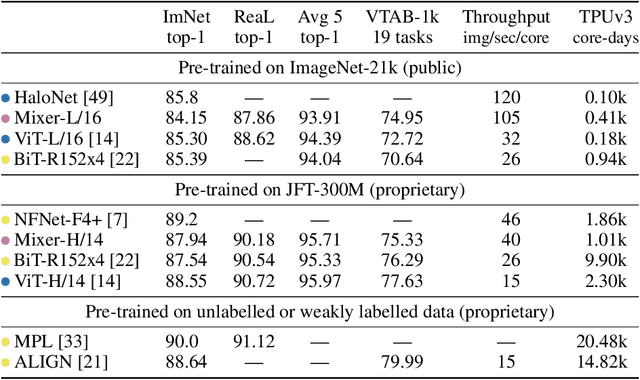
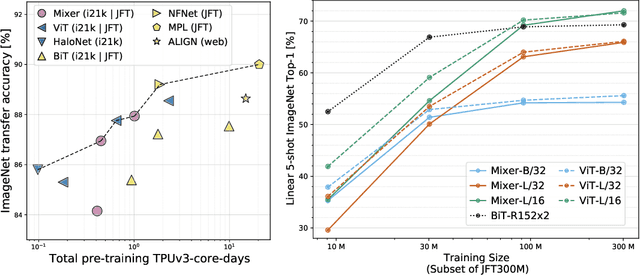
Abstract:Convolutional Neural Networks (CNNs) are the go-to model for computer vision. Recently, attention-based networks, such as the Vision Transformer, have also become popular. In this paper we show that while convolutions and attention are both sufficient for good performance, neither of them are necessary. We present MLP-Mixer, an architecture based exclusively on multi-layer perceptrons (MLPs). MLP-Mixer contains two types of layers: one with MLPs applied independently to image patches (i.e. "mixing" the per-location features), and one with MLPs applied across patches (i.e. "mixing" spatial information). When trained on large datasets, or with modern regularization schemes, MLP-Mixer attains competitive scores on image classification benchmarks, with pre-training and inference cost comparable to state-of-the-art models. We hope that these results spark further research beyond the realms of well established CNNs and Transformers.
Differentiable Patch Selection for Image Recognition
Apr 07, 2021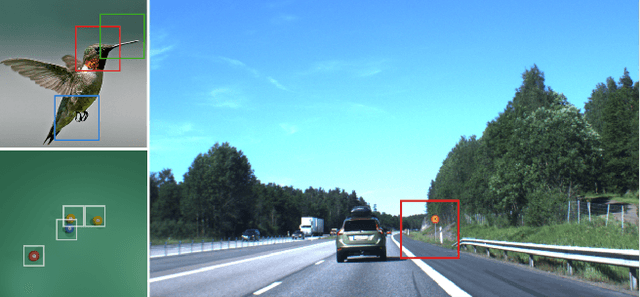
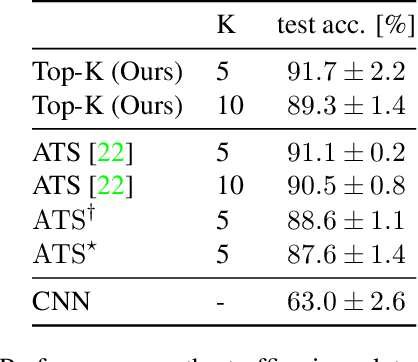

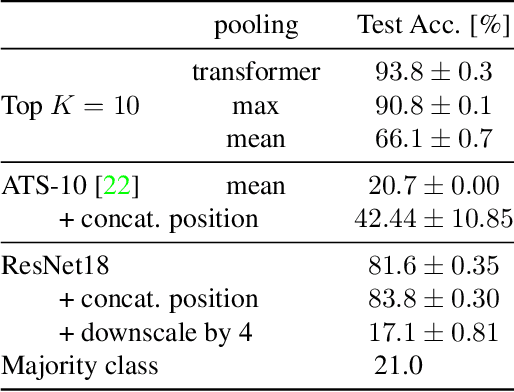
Abstract:Neural Networks require large amounts of memory and compute to process high resolution images, even when only a small part of the image is actually informative for the task at hand. We propose a method based on a differentiable Top-K operator to select the most relevant parts of the input to efficiently process high resolution images. Our method may be interfaced with any downstream neural network, is able to aggregate information from different patches in a flexible way, and allows the whole model to be trained end-to-end using backpropagation. We show results for traffic sign recognition, inter-patch relationship reasoning, and fine-grained recognition without using object/part bounding box annotations during training.
An Image is Worth 16x16 Words: Transformers for Image Recognition at Scale
Oct 22, 2020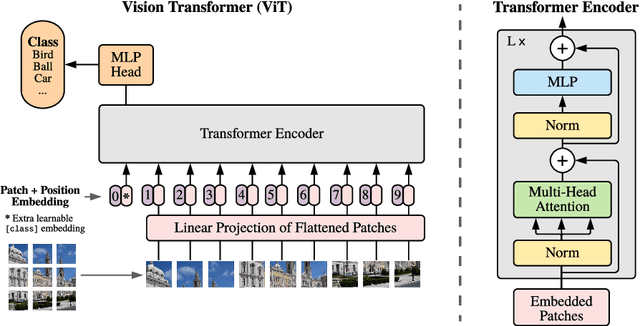



Abstract:While the Transformer architecture has become the de-facto standard for natural language processing tasks, its applications to computer vision remain limited. In vision, attention is either applied in conjunction with convolutional networks, or used to replace certain components of convolutional networks while keeping their overall structure in place. We show that this reliance on CNNs is not necessary and a pure transformer applied directly to sequences of image patches can perform very well on image classification tasks. When pre-trained on large amounts of data and transferred to multiple mid-sized or small image recognition benchmarks (ImageNet, CIFAR-100, VTAB, etc.), Vision Transformer (ViT) attains excellent results compared to state-of-the-art convolutional networks while requiring substantially fewer computational resources to train.
Towards End-to-End In-Image Neural Machine Translation
Oct 20, 2020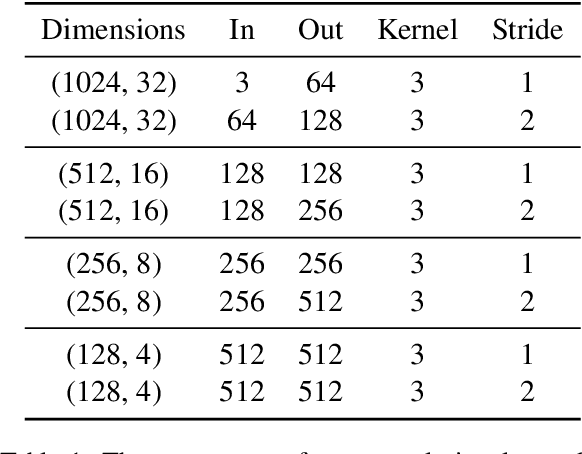

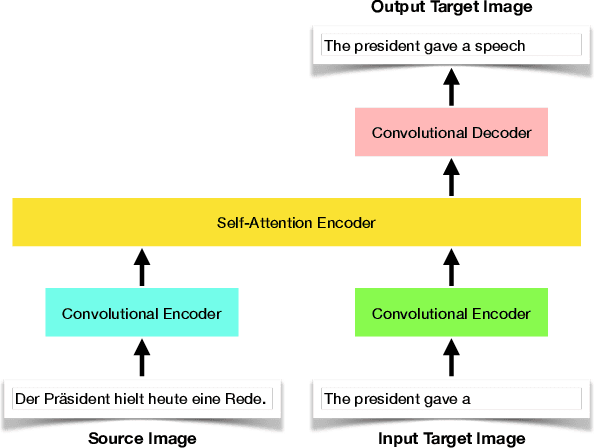
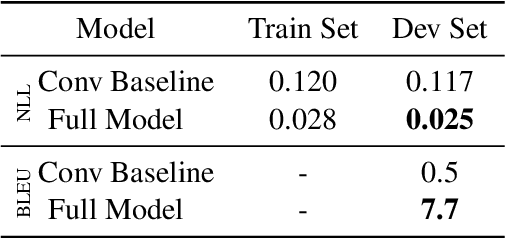
Abstract:In this paper, we offer a preliminary investigation into the task of in-image machine translation: transforming an image containing text in one language into an image containing the same text in another language. We propose an end-to-end neural model for this task inspired by recent approaches to neural machine translation, and demonstrate promising initial results based purely on pixel-level supervision. We then offer a quantitative and qualitative evaluation of our system outputs and discuss some common failure modes. Finally, we conclude with directions for future work.
Object-Centric Learning with Slot Attention
Jun 26, 2020Abstract:Learning object-centric representations of complex scenes is a promising step towards enabling efficient abstract reasoning from low-level perceptual features. Yet, most deep learning approaches learn distributed representations that do not capture the compositional properties of natural scenes. In this paper, we present the Slot Attention module, an architectural component that interfaces with perceptual representations such as the output of a convolutional neural network and produces a set of task-dependent abstract representations which we call slots. These slots are exchangeable and can bind to any object in the input by specializing through a competitive procedure over multiple rounds of attention. We empirically demonstrate that Slot Attention can extract object-centric representations that enable generalization to unseen compositions when trained on unsupervised object discovery and supervised property prediction tasks.
An Empirical Study of Generation Order for Machine Translation
Oct 29, 2019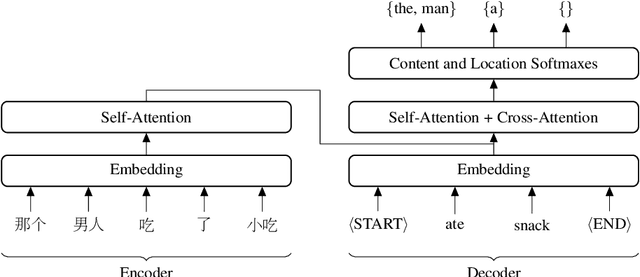
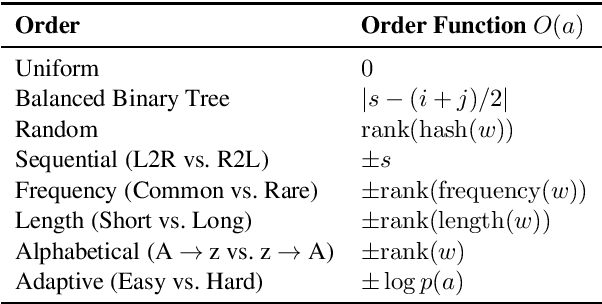

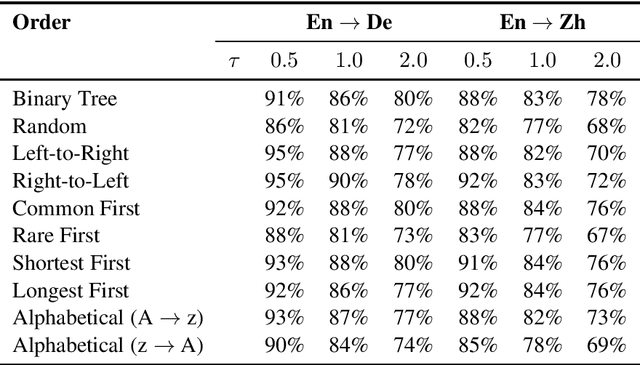
Abstract:In this work, we present an empirical study of generation order for machine translation. Building on recent advances in insertion-based modeling, we first introduce a soft order-reward framework that enables us to train models to follow arbitrary oracle generation policies. We then make use of this framework to explore a large variety of generation orders, including uninformed orders, location-based orders, frequency-based orders, content-based orders, and model-based orders. Curiously, we find that for the WMT'14 English $\to$ German translation task, order does not have a substantial impact on output quality, with unintuitive orderings such as alphabetical and shortest-first matching the performance of a standard Transformer. This demonstrates that traditional left-to-right generation is not strictly necessary to achieve high performance. On the other hand, results on the WMT'18 English $\to$ Chinese task tend to vary more widely, suggesting that translation for less well-aligned language pairs may be more sensitive to generation order.
Scaling Autoregressive Video Models
Jun 06, 2019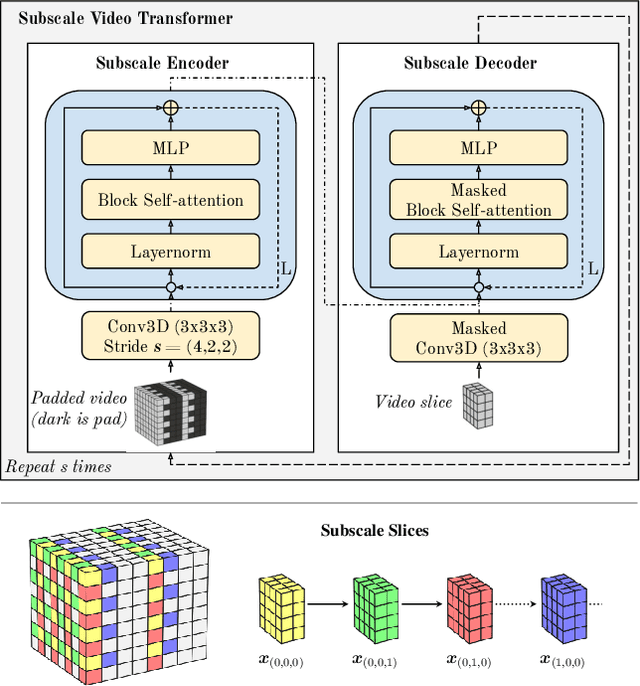


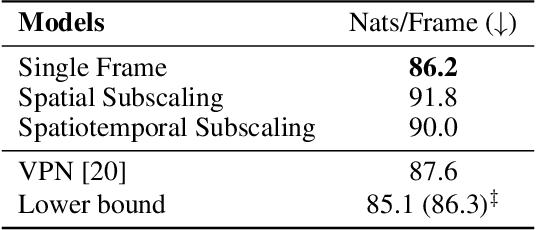
Abstract:Due to the statistical complexity of video, the high degree of inherent stochasticity, and the sheer amount of data, generating natural video remains a challenging task. State-of-the-art video generation models attempt to address these issues by combining sometimes complex, often video-specific neural network architectures, latent variable models, adversarial training and a range of other methods. Despite their often high complexity, these approaches still fall short of generating high quality video continuations outside of narrow domains and often struggle with fidelity. In contrast, we show that conceptually simple, autoregressive video generation models based on a three-dimensional self-attention mechanism achieve highly competitive results across multiple metrics on popular benchmark datasets for which they produce continuations of high fidelity and realism. Furthermore, we find that our models are capable of producing diverse and surprisingly realistic continuations on a subset of videos from Kinetics, a large scale action recognition dataset comprised of YouTube videos exhibiting phenomena such as camera movement, complex object interactions and diverse human movement. To our knowledge, this is the first promising application of video-generation models to videos of this complexity.
KERMIT: Generative Insertion-Based Modeling for Sequences
Jun 04, 2019

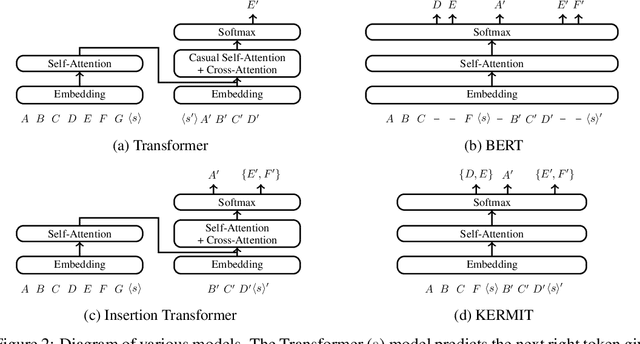
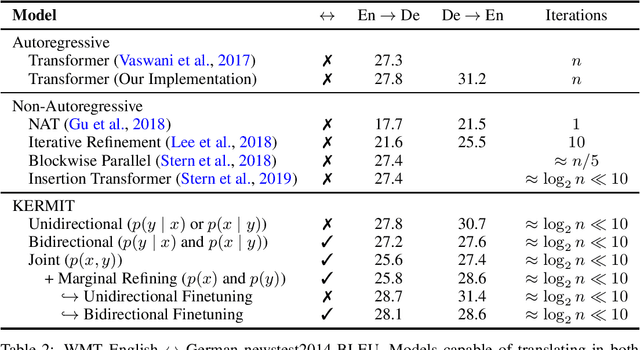
Abstract:We present KERMIT, a simple insertion-based approach to generative modeling for sequences and sequence pairs. KERMIT models the joint distribution and its decompositions (i.e., marginals and conditionals) using a single neural network and, unlike much prior work, does not rely on a prespecified factorization of the data distribution. During training, one can feed KERMIT paired data $(x, y)$ to learn the joint distribution $p(x, y)$, and optionally mix in unpaired data $x$ or $y$ to refine the marginals $p(x)$ or $p(y)$. During inference, we have access to the conditionals $p(x \mid y)$ and $p(y \mid x)$ in both directions. We can also sample from the joint distribution or the marginals. The model supports both serial fully autoregressive decoding and parallel partially autoregressive decoding, with the latter exhibiting an empirically logarithmic runtime. We demonstrate through experiments in machine translation, representation learning, and zero-shot cloze question answering that our unified approach is capable of matching or exceeding the performance of dedicated state-of-the-art systems across a wide range of tasks without the need for problem-specific architectural adaptation.
 Add to Chrome
Add to Chrome Add to Firefox
Add to Firefox Add to Edge
Add to Edge